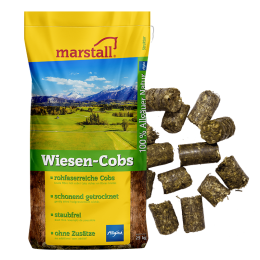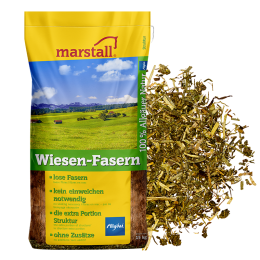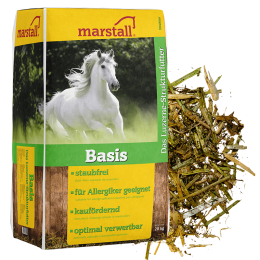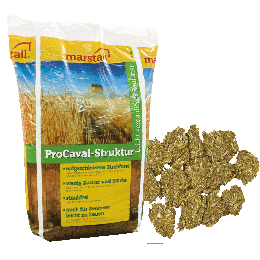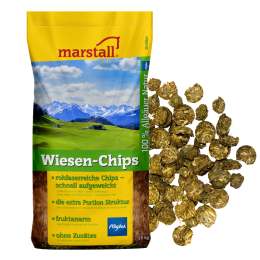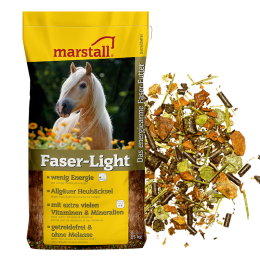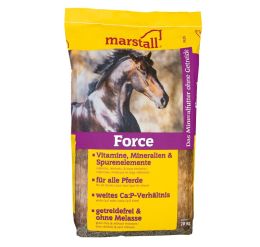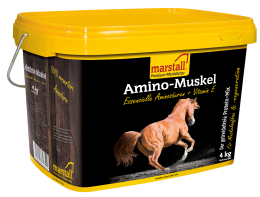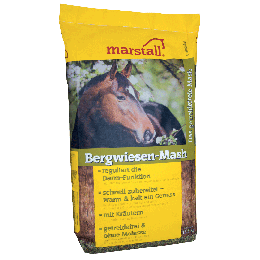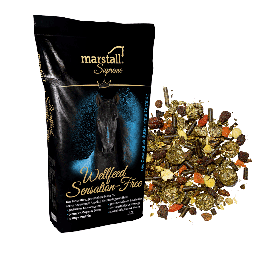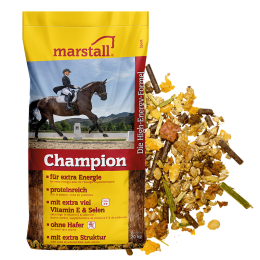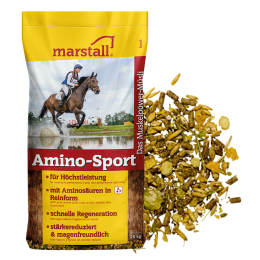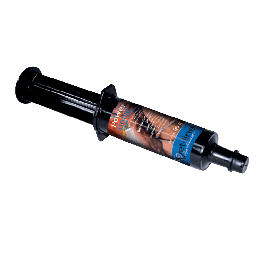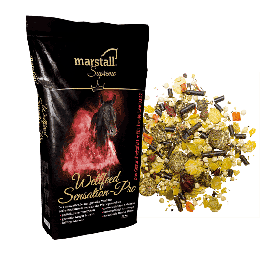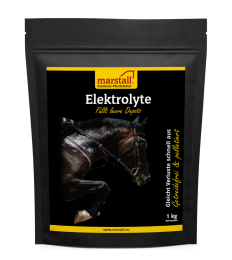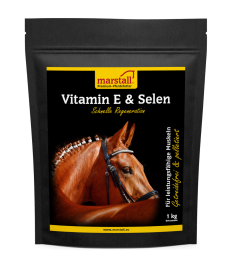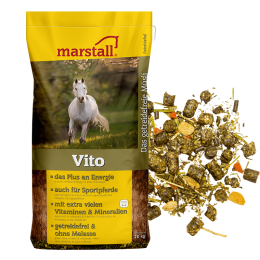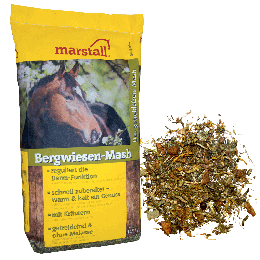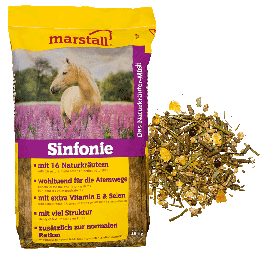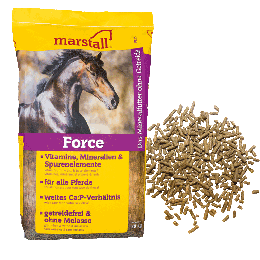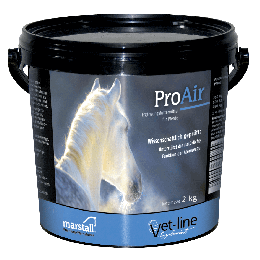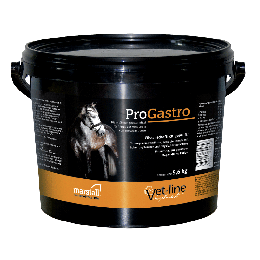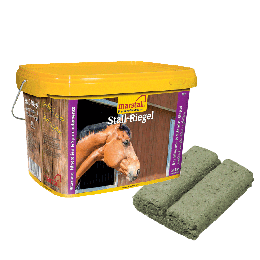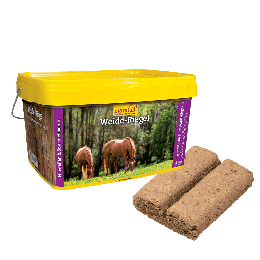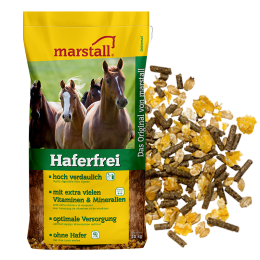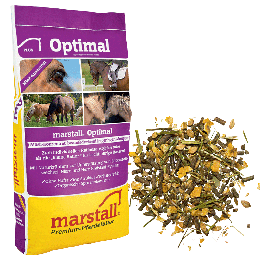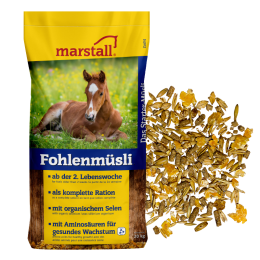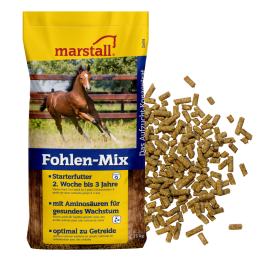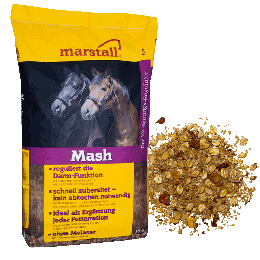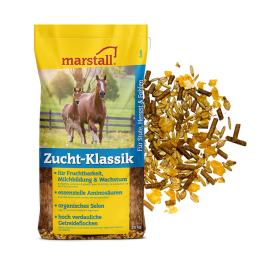Feed FAQ
Every day we receive numerous questions about horse-friendly feeding or our product range. In our feed FAQ we take up frequently asked questions and answer them in detail. The collection is constantly being expanded - therefore it is worthwhile to visit this page from time to time. And should you not find your question here, please do not hesitate to contact us. We look forward to hearing from you!
General horse feeding
How much hay does a horse eat in an hour?
In one hour a horse eats about 1.2 to 1.5 kg of hay or straw. It is usually said that a horse needs about 40 to 50 minutes for 1 kg of hay or straw. However, there are big differences between the individual animals. Horses with chewing problems can take considerably longer, while fast eaters can have eaten the kilo of hay in much less time.
Recommandation de produit sur le sujet
My horse is too fat. What do I have to look out for so that it lose weight healthily?
Please don't do a zero diet or too strong and abrupt food reduction, otherwise hyperlipemia is imminent! A tolerable reduction diet looks like this:
- Late cut hay (coarse stalked, little leaf mass) or hay-straw mixture (maximum one third straw) best fed from the hay net or the hay rack in an amount of 1 to 1.2% of the desired ideal weight (normal would be: 1.5%).
- Starch- or fat-rich concentrated feed should not be fed at all, at best energy-reduced, grain-free feed with concentrated mineralisation/vitaminisation like our marstall Faser-Light.
- Preferably no or only considerably restricted grazing or grazing with grazing muzzel
- Low-energy and low-starch mineral feed, which supplements missing minerals and vitamins.
- Supplementation of high-quality protein or essential amino acids to prevent muscle breakdown. Do not feed treats, bread or fruit. Occasional carrots or beetroot are allowed.
- Regular exercise (about 30 minutes of a good trot daily) improves insulin sensitivity.
- Sawdust is suitable as bedding (with straw the horse still eats out of the bedding).
- Aim for a weight loss of 0.5 to 1 % of body mass per week. The success of the reduction diet should be checked regularly by weighing and/or measuring the circumference of the body, neck or chest (1 to 2 cm reduction of measurements per week).
How do I know if my horse is too fat?
The best way is to determine the BCS (Body Condition Score) according to Schramme. The fat coverage of certain body regions (neck, shoulder, back, chest wall, hip, tail) is assessed and thus the overall condition is concluded. A BCS of 5 to 6 would be ideal.
Old horses / seniors
When is a horse considered old?
Horses over 20 years of age (e.g. warmblood) are considered old. In the case of ponies, aging usually starts later. Better than to fix it at the age, the term "old" should only be used when the typical signs of old age appear: Weight loss, tooth problems, muscle loss ...
Sports horses
Which things (energy, protein, minerals, vitamins etc.) do horses need more if they are sport horses?
Sport horses need more energy, more high-quality protein (essential amino acids), more electrolytes such as sodium, chlorine, potassium (as they get lost by sweating), more vitamins A and E, more trace elements such as iron, zinc, manganese and selenium.
In addition, sport horses need more water!
Recommandation de produit sur le sujet
Health
Is it true that laminitis does not come from protein?
That's right. According to current scientific knowledge, laminitis is not caused by protein, but by easily available sugar and fructans (long-chain sugars) from the grass. The hormone insulin, which regulates the blood sugar level, plays a decisive role in this process.
Recommandation de produit sur le sujet
My horse is coughing. What can I feed?
As a preventive measure, the horses can be sensibly supported by a "handful" of herbal feed. Warmly poured over, the horses breathe in the ethereal vapours already while eating.
If the horse coughs, a high dust load, fungus-contaminated, dusty roughage, litter or oats, as well as colds and infections can be the cause. A veterinarian should always be consulted, among other things, because long-term problems can become chronic.
We recommend for horses with coughs or susceptible respiratory tracts ...
... low-dust, if possible washed hay or alternatively soaked meadow cobs or perfect silage
... if possible low-dust bedding such as straw of very good quality or otherwise shavings.
... if oats are fed, ensure that the quality of the feed is low in dust and clean.
... Antioxidants such as vitamin C, E and selenium as well as a feeding of zinc and vitamin D as required.
... anti-inflammatory substances like MSM.
... Herbs to support the respiratory function.
... Plenty of fresh air, if possible an outside box if stabled.
My horse is too fat. What do I have to look out for so that it lose weight healthily?
Please don't do a zero diet or too strong and abrupt food reduction, otherwise hyperlipemia is imminent! A tolerable reduction diet looks like this:
- Late cut hay (coarse stalked, little leaf mass) or hay-straw mixture (maximum one third straw) best fed from the hay net or the hay rack in an amount of 1 to 1.2% of the desired ideal weight (normal would be: 1.5%).
- Starch- or fat-rich concentrated feed should not be fed at all, at best energy-reduced, grain-free feed with concentrated mineralisation/vitaminisation like our marstall Faser-Light.
- Preferably no or only considerably restricted grazing or grazing with grazing muzzel
- Low-energy and low-starch mineral feed, which supplements missing minerals and vitamins.
- Supplementation of high-quality protein or essential amino acids to prevent muscle breakdown. Do not feed treats, bread or fruit. Occasional carrots or beetroot are allowed.
- Regular exercise (about 30 minutes of a good trot daily) improves insulin sensitivity.
- Sawdust is suitable as bedding (with straw the horse still eats out of the bedding).
- Aim for a weight loss of 0.5 to 1 % of body mass per week. The success of the reduction diet should be checked regularly by weighing and/or measuring the circumference of the body, neck or chest (1 to 2 cm reduction of measurements per week).
How do I recognize a stomach ulcer?
Oft sind Magengeschwüre symptomlos und erst durch Magenspiegelung zu diagnostizieren. Wenn überhaupt, dann zeigen die Pferde (oft erst ab einem höheren Schweregrad) Anzeichen wie Kolik, Leistungsminderung, schlechtes Fell, selektives Fressverhalten, Gewichtsabnahme, etc. Nicht nur Sportpferde sind betroffen, sondern auch Zucht- und Freizeitpferde. Magengeschwüre gibt es in mehreren Bereichen des Magens und die Ursachen sind vielfältig: Lange Fresspausen, Training und körperliche Belastung, hohe Getreidemengen pro Mahlzeit, zu wenig Heu / Raufutter, grobstängelige Luzernehäcksel …
Recommandation de produit sur le sujet
Paddock & Pasture
Do I actually have to feed the horse something in addition when he goes out to pasture all day?
If there is enough pasture grass a mineral feed is sufficient. A supplementation with vitamins or amino acids is not necessary.
If grass is scarce (pasture for moving around) hay and a mineral feed that also contains vitamins should be fed. Make sure that you also take sufficient amino acid supplements.
Recommandation de produit sur le sujet
Should I feed something extra during all-day pasture?
If there is enough pasture grass a mineral fodder is sufficient. A supplement with vitamins or amino acids is not necessary.
Recommandation de produit sur le sujet
Roughage
How much hay does a horse eat in an hour?
In one hour a horse eats about 1.2 to 1.5 kg of hay or straw. It is usually said that a horse needs about 40 to 50 minutes for 1 kg of hay or straw. However, there are big differences between the individual animals. Horses with chewing problems can take considerably longer, while fast eaters can have eaten the kilo of hay in much less time.
Recommandation de produit sur le sujet
Why is horse hay harvested later than cow hay?
In order to contain less energy and protein, instead it contains more crude fibre and can be chewed longer.
Leisure horse
How can I still feed my horse on demand with little concentrated feed?
It is important that the horses are sufficiently supplied with minerals, trace elements and vitamins. A concentrated, thus enriched muesli (with or without grain) or, in the case of pure hay feeding, a high-quality mineral feed is recommended.
Recommandation de produit sur le sujet
Youngster/ Young horses
Which is better to feed: Fohlenmüsli or Fohlen-Mix + oats or Complete?
We recommend to an amateur breeder to feed the Fohlenmüsli. For the professional breeder the economical combination of Fohlen-Mix + oats or Complete.
Recommandation de produit sur le sujet
Horse at rest
Which products are the most reasonable without putting too much strain on my horse's metabolism?
First of all, hay in large quantities is important. In addition, there are products that already cover the daily requirements with a small amount of concentrated feed or only mineral feed.
A 600 kg warmblood needs approx. 63 MJ ME/day to maintain (= without work). At least 9 kg hay should be fed daily to the warmblood (~ 6.0 MJ ME/kg).
The rest can be fed either on hay: so a total of 10 to 11 kg hay + high-quality mineral feed.
Or alternatively 9 kg hay + concentrated food + possibly balanced with mineral food.
With all variants amino acid additions are recommendable, so that the muscle mass remains.
Mash helps to prevent digestive disorders caused by lack of exercise.
Breeding
I want to have my mare covered. What do I have to pay attention to when feeding?
- The mare should be in a good to very good feed condition (the hormone status is strongly influenced by the body fat stock). A body condition score of 6 to 6.5 would be ideal. If the mare is below this level, she should receive extra concentrated feed 6 to 8 weeks before the mare is taken.
- High-quality protein, respectively essential amino acids, are useful around the covering.
- Beta-carotene dosages before the mating date improve the start of heat.
- The mare must be supplied with iodine, selenium, vitamin A and E as required.
Our breeding muesli "Zuchtmüsli" is adapted to these special requirements.
By the way: The nutrients mentioned are often in short supply in mature hay or late mowed 1st cut. The hay must therefore be of high quality, especially when mating in the winter months.

